A recreational vehicle (RV) breaks the silence of the New Mexico desert. The driver, wearing only his underpants and a gas mask and showing signs of middle-age spread, steers it crashing into the embankment. The door bursts open, the driver falls out and, cursing, rips the gas mask from his face: Walter H. White, 50 years old, glasses and a highly talented scientist who is increasingly disillusioned in his work at a High School in Albuquerque. To help his family make ends meet, Walter is forced to take on a side job working at a car wash.
Walter H. White: hero or anti-hero? Driving force or driven by other forces? Chemist! Welcome to Breaking Bad.

Figure 1. Introducing Walter H. White, Chemist (© 2008 Sony Pictures Television Inc. All Rights Reserved).
Walter H. White is the protagonist of the multi-award-winning American TV series Breaking Bad, which runs for a total of five seasons and is especially popular among young audiences.
At the beginning of the series, he is diagnosed with lung cancer and, in face of his seemingly unavoidable and imminent death, he searches for a way to establish financial security for his heavily pregnant wife, Skyler, and his handicapped son, Walter Jr. On hearing how much money can be made in the narcotics business, he accompanies his brother-in-law, Hank Schrader, who works for the DEA (Drug Enforcement Agency) on a raid. He recognizes his former student, Jesse Pinkman (see Fig. 2), fleeing the scene.
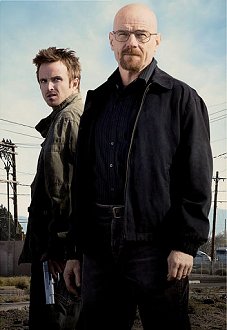
Figure 2. Walter H. White (Bryan Cranston, front) and Jesse Pinkman (Aaron Paul). A duo as contrasting as they are successful (© 2008 Sony Pictures Television Inc. All Rights Reserved).
With a mixture of cool calculation and pure desperation, Walter decides to get involved in the narcotics business and to synthesize crystal meth (N-methylamphetamine) to a very high quality. He forces Jesse into a partnership by mentioning his connections to the DEA in order to establish the contacts necessary for the sales and distribution of the meth.
This rather involuntary but apparently logical combination of scientific expertise and knowledge of the drug market experiences its highs and lows throughout the series, just as one might often find in other business start-ups [1].
The financial aspects, the middle-class educational aspects and the influence of Walter’s new line of work on his personality, or the catastrophic effects of drug use [2], will only be minor concerns of the following article. The focus here is on the chemistry in Breaking Bad and its portrayal and plausibility.
Crystal Meth – The “Chemical Star of the Show”
N-methylamphetamine ((S)-N-methyl-1-phenyl-propane-2-amine), also known as meth, crystal, or pervitin, is the drug at the center of Breaking Bad. Scientific literature details many different means of synthesis [3], which are all to be found to varying extents in grey literature and blogs. As the authors do not have practical knowledge in synthesizing crystal meth, they can only rely on such sources.
Throughout the story, two different methods of synthesis are used (see Fig. 3).
Standard Synthesis
At the beginning, Walter pursues synthesis using pseudoephedrine. This is used in the real world, as well as in Breaking Bad by many meth cooks. However, by applying his knowledge of chemistry, his experimental abilities, and a half-way professional lab set-up, Walter is able to achieve much better results.
The base substance, pseudoephedrine is a plant-based phenyl ethylamine alkaloid and is used comme.jpg) rcially in treatments for nasal and sinus congestion and can be extracted from these treatments. Due to the restrictions on sale, an extensive procurement network is required, which generally means involving a large number of drug addicts, in order to secure the necessary quantities. As the drug addicts can really only acquire the smallest of quantities each time by this “smurfing”, which involves either getting prescriptions for it or stealing it, the availability of this base substance is always a critical factor.
rcially in treatments for nasal and sinus congestion and can be extracted from these treatments. Due to the restrictions on sale, an extensive procurement network is required, which generally means involving a large number of drug addicts, in order to secure the necessary quantities. As the drug addicts can really only acquire the smallest of quantities each time by this “smurfing”, which involves either getting prescriptions for it or stealing it, the availability of this base substance is always a critical factor.
Blue-Meth Synthesis
Walter proceeds to develop a synthesis method based on methylamine, acetic acid, and phenyl acetic acid, although acquiring this brings its own, new challenges (see below). It is, however, not entirely clear which sources Jesse gets certain ingredients for the new synthesis from (e.g., the thorium oxide catalyst) – not from the neighborhood pharmacy for sure.
As can be seen from the synthesis route in Figure 3 and by considering the stereochemistry, the alternative synthesis route most likely involves the production of the less intoxicating racemate (more information). Unfortunately, this makes the remarkable effect of the product, which is often emphasized in the series, rather inconceivable.
The fact that the (S)-N-methylamphetamine is pharmacologically considerably more effective than the R isomer [2] should lead us to assume that the racemate has a weaker effect. The characters – or at least the minds behind the story – seem, however, to be aware of this discrepancy. Walter asks a rhetorical question to save himself from a desperate situation by demonstrating his superior knowledge and thus that he is indispensable: “If our reduction isn’t stereospecific, how can our product be enantiomerically pure?” (Episode IV-1).
Another key characteristic of Walter’s product is its blue color, which leads to it being referred to as “Blue Meth” (see Fig. 4). It remains unclear, however, where this blue color comes from and can likely be assumed to be a dramaturgical instrument. It can only be speculated that characteristic impurities, e.g., from the base substance or by-products of the synthesis, could cause such blue coloring. It has already been shown that such a signature from different synthesis routes or producers can generally be analytically identified [3].
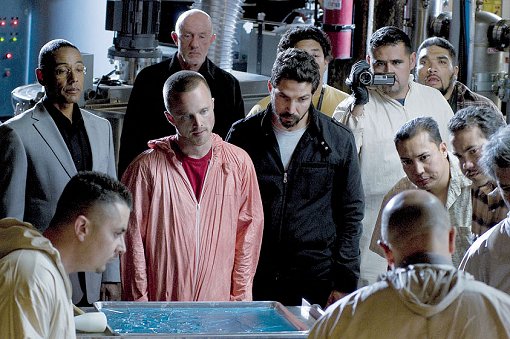
Figure 4. Gus Fring (left), Mike Ehrmantraut (back), Jesse (middle), and members of the Mexican drug cartel examine the Blue Meth produced by Jesse (© 2008 Sony Pictures Television Inc. All Rights Reserved).
Statements about the purity of the crystal meth are generally made throughout the series on a very phenomenological level (Episode I-1) or only the analytical result is announced (Episode I-4). The analytical methods are not really explained except for a few vague exceptions. For example, a gas chromatograph is used in a Mexican drug lab without further explanation (Episode IV-10).
In Breaking Bad, the chemistry is, thus, clearly depicted as a manufacturing science and not as an analytical science.
Starting an Engine with a Makeshift Battery!?
On their way to becoming the top dogs among the drug manufacturers in New Mexico, Walter and Jesse gradually improve their laboratory equipment. Walter steals some basic equipment and chemicals from his school and Jesse gets hold of more specialized equipment through shady channels. However, it is really not possible to carry out laboratory-scale synthesis in Walter’s school lab or even the town without attracting attention. So Walter and Jesse acquire a recreational vehicle (RV) that can function as a lab, and they drive out into the desert to cook.
During the first long phase of production, there is a chain of unfortunate incidents, not least due to Jesse’s lack of thought, which result in the RV battery running completely flat (Episode II-9). There seems to be no way to start the RV’s engine. Stranded in the middle of nowhere, Walter and Jesse slowly begin to panic, as one could expect. But Walter’s chemistry knowledge is also of assistance here. Using screws, dollar coins (galvanized metal), and brake pads (graphite blocks with mercury oxide) he builds electrochemical cells. This proves enough energy to start the engine and saves them both from dying of thirst.
 However, the battery that Walter made would really only supply a maximum of 9.66 V even in a highly simplified and ideal scenario. Would this voltage be enough to start an RV’s engine? Probably not. 12 V batteries are the norm and there can be an extreme voltage drop (>10 V), especially for cold starts. The main problem, however, is that the thin cables used by Walter to connect the galvanic cells seem unsuitable to convey the typical minimum current (400 A) required to start an engine.
However, the battery that Walter made would really only supply a maximum of 9.66 V even in a highly simplified and ideal scenario. Would this voltage be enough to start an RV’s engine? Probably not. 12 V batteries are the norm and there can be an extreme voltage drop (>10 V), especially for cold starts. The main problem, however, is that the thin cables used by Walter to connect the galvanic cells seem unsuitable to convey the typical minimum current (400 A) required to start an engine.
Interacting with Suppliers, Competitors, and Other Business Partners
Success in sales is normally not only a question of the product quality, but also of marketing and logistics. Jesse and Walter do not have to concern themselves much with marketing. The quality of their Blue Meth speaks for itself. Jesse also identifies drug therapy centers as a potential market for the product. Saying that they are looking to come off the drug, he takes part in sessions with a few friends to enthuse to the junkies there about the indescribable highs they experienced with the Blue Meth.
The question of logistics and, in particular, sales remain. Walter and Jesse quickly realize that violence is a common and effective means of asserting market interests in the narcotics business.
 Their experience with violence takes place right from the pilot episode (I-1), with their first experience involving the small-time dealers Emilio and Krazy-8. The situation escalates during a negotiation in the desert when Emilio mistakes Walter for a DEA spy. Walter can only manage to rescue his and Jesse’s lives by luring the dealers into the mobile drug lab, throwing some red phosphorus into a previously heated fluid, storming out of the RV and barring the door from the outside. Emilio is killed by the resulting phosphine in the RV. Krazy-8 initially survives the severe poisoning, but is later strangled by Walter in the cellar of Jesse’s house.
Their experience with violence takes place right from the pilot episode (I-1), with their first experience involving the small-time dealers Emilio and Krazy-8. The situation escalates during a negotiation in the desert when Emilio mistakes Walter for a DEA spy. Walter can only manage to rescue his and Jesse’s lives by luring the dealers into the mobile drug lab, throwing some red phosphorus into a previously heated fluid, storming out of the RV and barring the door from the outside. Emilio is killed by the resulting phosphine in the RV. Krazy-8 initially survives the severe poisoning, but is later strangled by Walter in the cellar of Jesse’s house.
Have Emilio’s Body Disappear Without Trace
The necessity to have Emilio’s body disappear without a trace triggers one of the most bizarre scenes in the entire series of Breaking Bad (Episode I-2). Walter steals two canisters of hydrofluoric acid from his school and tells Jesse to go and buy a large plastic tub made of polythene.
 Jesse approaches this task with little motivation and cannot find a tub in the hardware store that seems big enough. He heads home empty handed and throws the body into his ceramic bathtub in the upstairs bathroom. He pours in the acid and leaves the room. Walter arrives at Jesse’s house a little later and is horrified. He can only look on as the bathtub crashes through the ceiling and the amorphous remains of Emilio’s body splash across the floor.
Jesse approaches this task with little motivation and cannot find a tub in the hardware store that seems big enough. He heads home empty handed and throws the body into his ceramic bathtub in the upstairs bathroom. He pours in the acid and leaves the room. Walter arrives at Jesse’s house a little later and is horrified. He can only look on as the bathtub crashes through the ceiling and the amorphous remains of Emilio’s body splash across the floor.
Despite the fact that the scene is filmed to maximize the shock effect, certain basics regarding the handling of chemicals are impressively communicated.
In a later episode (IV-1) Walter and Jesse carry out this task much more professionally. A henchman who is killed by drug boss Gus Fring personally is quickly thrown into a chemical barrel, which is then filled with hydrofluoric acid. They seal the barrel, which bears the warning “CORROSIVE”, and take it to the waste disposal site with other chemical waste.
Tuco and the Fulminated Mercury
Once Emilio and Krazy-8 have successfully been reduced to their chemical constituents, Walter and Jesse encounter the drug dealer Tuco. This man is living proof that intelligence and a tendency to violence are generally inversely proportional. Jesse is beaten up by T uco in a fit of rage and Tuco has to be brought to reason by Walter, or “Heisenberg” as he now calls himself. To do this, he visits Tuco in his office, pretending to be making a meth delivery. When Tuco threatens Walter too, Walter throws a crystal on the floor and the resulting explosion destroys the room. Walter makes clear that the bag of supposed meth crystals he carries with him is also explosive and he threatens to destroy the entire building. He explains that it is fulminated mercury “… a little tweak of chemistry”.
uco in a fit of rage and Tuco has to be brought to reason by Walter, or “Heisenberg” as he now calls himself. To do this, he visits Tuco in his office, pretending to be making a meth delivery. When Tuco threatens Walter too, Walter throws a crystal on the floor and the resulting explosion destroys the room. Walter makes clear that the bag of supposed meth crystals he carries with him is also explosive and he threatens to destroy the entire building. He explains that it is fulminated mercury “… a little tweak of chemistry”.
Tuco is visibly stunned and cooperates. He pays the sum Walter had demanded without further question and agrees to continue doing business.
Entering a Chemical Warehouse with Thermite
The thriving drug business brings its own problems with it, as Jesse cannot acquire enough pseudoephedrine to manufacture the 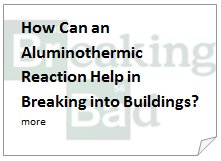 required quantities of crystal meth. So Walter develops a new method of synthesis using base chemicals (see Fig. 3). This new method requires methylamine among other chemicals, which they choose to steal from a chemical warehouse.
required quantities of crystal meth. So Walter develops a new method of synthesis using base chemicals (see Fig. 3). This new method requires methylamine among other chemicals, which they choose to steal from a chemical warehouse.
During their break-in under the cover of darkness, they first put the watchman out of action before opening the door with a thermite charge. Although they are successful in the end, they are a little clumsy in doing it. Hank Schrader describes them as morons when he watches them on the security camera recording, although he does not recognize them through their disguises.
Attempt to Poison Tuco with Ricin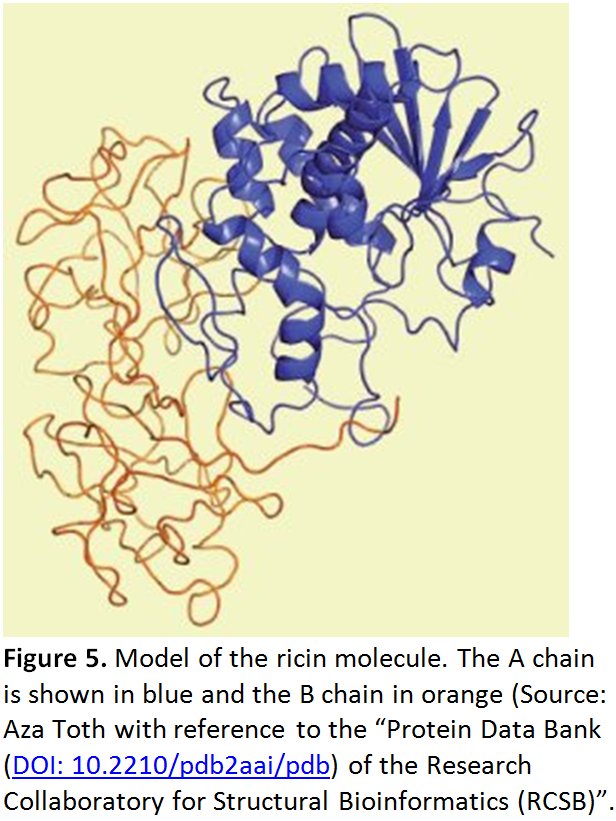
The Blue Meth sells so well that Tuco starts to think of producing it on a really large scale in Mexico under the umbrella of the Mexican drug cartel. He kidnaps Walter and Jesse and takes them to the house of his uncle, Hector Salamanca, who lives alone way out in the New Mexico desert. There, he waits for his cousins, who are to take Walter and Jesse to Mexico (Episode II-2).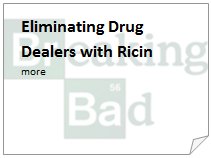
Hector had worked as a hitman for a Mexican drug cartel for many years, but now sits in a wheelchair after a stroke had paralyzed him. He can only communicate with a bell attached to his wheelchair. Seeing the coming difficulties, Walter tries to poison Tuco with ricin (see Fig. 5), which he secretly sprinkles on an enchilada. Hector warns his nephew by anxiously ringing the bell – Walter’s attempt fails. Tuco, however, is shot shortly afterwards by Hank Schrader.
Gus Fring’s Drug Lab
On the search for a new middleman, Walter and Jesse get involved with Gus Fring, who is high up in the narcotics business hierarchy and operates the “Los Pollos Hermanos” fast food chain as a cover. Gus sets up a professional, industrial-scale synthesis lab in the basement of a laundry, which allows several hundred kilograms of crystal meth to be produced every week (see Fig. 6).
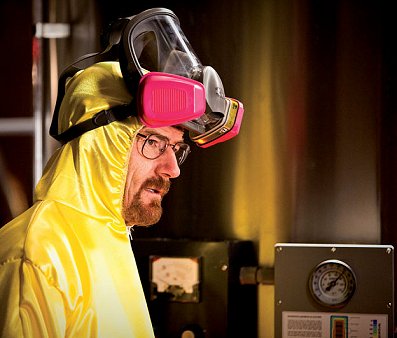
Figure 6. Walter cooking in Gus Fring’s drug lab (© 2008 Sony Pictures Television Inc. All Rights Reserved).
Unfortunately, the chemist hired by Gus, Gale Boetticher, does not even come close to achieving the quality of Walter’s product. Gus makes Walter a significant financial offer to train Gale, after which Walter is to be eliminated, because Gus considers him to be unreliable.
Walter, having initially accepted the offer, suspects there is a trap. Before the hitman, Mike Ehrmantraut, can get to work, Walter makes sure that Gale is shot by Jesse to protect their own interests. The pair are now forced to work together again.
The Mexican Drug Cartel
The Mexican drug cartel has now also become active. They are dissatisfied with the overall situation because the Mexican market is dominated by Blue Meth and several of their members have met their deaths in violent circumstances. Jesse is sent to Mexico to deescalate the situation by explaining the synthesis of Blue Meth to the cartel members. The arrogant way that Jesse, clearly clueless about anything involving natural sciences, explains the scientific basics to the experienced lab head is an insult to all genuine chemists (Episode IV-10). The subsequent gas chromatographic analysis of the product proves him right, both to his own surprise and to the surprise of all those present in the scene. Gus takes advantage of the moment and kills the entire drug cartel, then returns to Albuquerque with Jesse.
Walter finally realizes that he cannot survive the end of the business relationship with Gus Fring and begins to plan his demise. He gets Jesse on his side by poisoning a boy close to Jesse with glycosides from lily of the valley (see Fig. 7) and blaming it on Gus. Hector Salamanca takes on the role of a suicide bomber in Gus’s presence by detonating a bomb, which Walter had attached to his wheelchair, with his bell.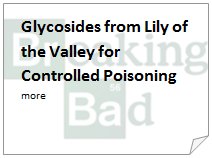
After Gus’s death, Walter and Jesse destroy the evidence by setting fire to the meth lab. The last scene of the fourth series sees the camera swing over Walter’s home and stop at a potted plant. In the close-up, the name “Lily of the Valley” can be read clearly.
Final Excursion: STEM and the Media
Scientists, technologists, engineers, and mathematicians (STEM) often play lesser roles in cinema and TV. They are often seen as the nerds and tend to stand on the side lines. Science fiction often portrays the scientist as either a hero or a madman in exaggerated fashion, or as a rather bizarre character in comedy [4]. If chemistry is shown at all, it is often outrageously inaccurate. A classic example of this is the film “Lover Come Back” from 1961. During the story, a Nobel Prize Winner improves his cyclohexane formula by substituting a –CH3 group with a –CH4 group! In the German cult classic “Die Feuerzangenbowle”, there is also a terrible mistake. The following can be read on the chemistry classroom blackboard: “Alcoholic fermentation: H6P5O11 → Cane Sugar”.
In Breaking Bad, there is none of this. On the contrary: serious scientific subjects are skillfully integrated into the conversations in developing the tension between the characters.
In Episode (III-4), Walter and Jesse argue about the quality of the meth Jesse produces using the second method. Walter: “What did you use for the reduction? Don’t tell me. Platinum dioxide, right?” Jesse: “No. Mercury–aluminium amalgam. The dioxide’s hard to keep wet.”
Walter especially likes to use such exchanges to strengthen his position by showing off his seemingly superior knowledge. He displays a through-and-through materialistic view of the world, in which chemistry plays a key role. This becomes obvious when, in discussion with a friend, he calculates the sum of the elementary components of the human body at 99.888042 %. He blankly refuses to accept his friend’s proposal that the missing 0.111958 % could be the soul [5].
In a conversation with Gus Fring in Episode (III-5), Walter explains his motivation behind creating particularly pure crystal meth in two simple sentences: “I simply respect the chemistry. The chemistry must be respected.” He is deeply depressed to see that first Jesse and then one of Gus Fring’s henchmen are able to produce excellent-quality crystal meth according to his method without the slightest understanding of chemistry.
Beyond Breaking Bad, it is almost impossible to find intelligent, scientifically-based dialogues in film. In some dramas, such as “A Beautiful Mind”, “Proof”, “Good Will Hunting”, and “Straw Dogs”, mathematicians play the central role in the story. But these films are mostly interested in the psychological profile of the character rather than their science. The picture is similar in literature. One seldom finds good fiction with scientific content. The result is that the STEM professions do not appear particularly attractive to many young people. This is reflected in their choice of profession and the resulting shortage of qualified people.
Guggolz and Karger complained about the “… public opinion and choosy young students as a problem for science in general and chemistry in particular” years ago [6]. Although the advantages of a sound education in chemistry were impressively demonstrated by using the example of the jungle hero Tibor (a character drawn by the cartoonist Hansrudi Wäscher similar to the Tarzan figure), the well-intended attempt completely backfired among about half of the population. It quickly becomes clear to a reader that a chemistry nerd, such as Peter Parker (alias Spiderman), has little chance with the girls [6].
Klaus Roth also embarks on a search for the soul of science on comic literature terrain and analyzes the weaknesses of German university education based on the suffering of the chemistry student Donald Duck [7]. The context shows a popular but severely distorted or simply wrong film presentation of natural scientific forensic methods. One may doubt that this so-called “CSI effect” will really be of any long-term benefit to STEM professions [8].
But back to Breaking Bad ...
Apart from the largely correct depiction of scientific details, this TV series is perfect for an entertaining TV evening after a hard day in the lab. It is demanding, exciting, amusing, often shocking, and made with great attention to chemistry details.
At the beginning and during the credits, the cast’s names are shown containing chemical symbols. A small error is noticeable in episode (I-7): the element symbol “T” is not to be found on the periodic table.
The methods used by the drug cartel are quite realistic, as far as the literature can be trusted [9]. Chemists learn from the Jesse Pinkman character about the daily disadvantages experienced by someone with little education in natural sciences. On the other hand, Gale Boetticher’s fate shows that too much knowledge at the wrong time can be fatal. So too little knowledge is dangerous, too much knowledge too [10]. Walter H. White remains. He applies his analytical mind both within the lab and outside, which saves his life numerous times in his interaction with drug dealers, other criminals, and the DEA.
Breaking Bad is at least as addictive as Walter’s Blue Meth. Anyone interested in watching the series is, however, strongly advised to watch all the episodes chronologically. And maybe Walter H. White might just tempt one or two viewers onto the virtuous path of a STEM university course. The drug trail in series 5 leads to Hanover, Germany, – that much we know. We here in Braunschweig have always suspected as much …!
Acknowledgements
Prof. Dr. Uwe Hohm, Braunschweig University of Technology (TU Braunschweig), Brunswick, Germany, and Dr. Wolf-Ulrich Palm, Leuphana University, Lüneburg, Germany, have significantly enriched this article with their many useful suggestions, tips, and corrections. We wish to take this opportunity to thank them.
References
[1] B. Osterath, Nachr. Chem. 2011, 59, 427–428. DOI: 10.1002/nadc.201177777
[2] C. W. Meredith, C. Jaffe, K. Ang-Lee, A. J. Saxon, Harv. Rev. Psychiatry 2005, 13, 141–154. DOI: 10.1080/10673220591003605
[3] N. Stojanovska, S. Fu, M. Tahtouh, T. Kelly, A. Beavis, K. P. Kirkbride, Forensic Sci. Int. 2013, 224, 8–26. DOI: 10.1016/j.forsciint.2012.10.040
[4] S. Perkowitz, Hollywood Science, Columbia University Press, New York, 2007.
[5] D. R. Koepsell, R. Arp, Breaking Bad and Philosophy, Open Court Publishing, Chicago, 2012; Vol. 67.
[6] E. Guggolz, G. Karger, Nachr. Chem. 2000, 48, 490–495. DOI: 10.1002/nadc.20000480419
[7] K. Roth, Chem. Unserer Zeit 2004, 38, 128–132. DOI: 10.1002/ciuz.200490022
[8] M. Jäckel, Medienwirkungen, VS Verlag für Sozialwissenschaften, Wiesbaden, Germany, 2011.
[9] I. Grillo, El Narco – The Bloody Rise Of Mexican Drug Cartels, Bloomsbury Publishing, London, 2011.
[10] A. Fischer, Nachr. Chem. 2011, 59, 621. DOI: 10.1002/nadc.201181792
[11] R. M. Herbst, R. H. Manske, Methyl Benzyl Ketone, Organic Synthese 1936, XVI, 47.
[12] N. Wiberg, Hollemann–Wiberg: Lehrbuch der Anorganischen Chemie, 102 Ed., Walter de Gruyter, Berlin, 2007.
[13] Air Liquide Deutschland GmbH, Sicherheitsdatenblatt Phosphin (gemäß RL 1907/2006EG). Rev.-Ausgabe Nr. 3-01 vom 7.2.2011, Sicherheitsdatenblatt-Nr.: 100-ALD, Düsseldorf.
[14] J. Angerer, M. Fleischer, G. Machata, W. Pilz, K. H. Schaller, H. Seiler, M. Stoeppler, H. Zorn, Aufschlußverfahren zur Bestimmung von Metallen in biologischem Material, The MAKCollection for Occupational Health and Safety, Wiley-VCH, Weinheim, 2002.
[15] K. Bensmann, Chem. Unserer Zeit 2007, 41, 427. DOI: 10.1002/ciuz.200790065
[16] W. Beck, J. Evers, M. Göbel, G. Oehlinger, T. M. Klapötke, Z. Anorg. Allge. Chem. 2007, 633, 1417–1422. DOI: 10.1002/zaac.200700176
[17] F. W. Hall, Aluminothermic Processes, Ullmann’s Encyclodedia of Industrial Processes, Wiley-VCH, Weinheim, 2012, 471. DOI: 10.1002/14356007.a01_447
[18] E. A. E. Garbner, J. Food Prot. 2008, 71, 1875–1883. Link
[19] D. Frohne, H. J. Pfänder, Giftpflanzen, Wissenschaftliche Verlagsgesellschaft, Stuttgart, 2004.
The Authors
 Falk Harnisch grew up in the “Valley of the Clueless” and took part in the last “Pioneer” year in the communist German Democratic Republic (GDR). A comical early phase of his literary socialization, influenced by Hannes Hegen and Matt Groening, was followed by a (still continuing) historical and montane phase, the latter also involving practical experience. During his biochemistry studies at Greifswald, Germany, he developed an interest in electrochemistry and continued on to add a doctorate in environmental chemistry. Following time spent at the TU Braunschweig, Germany, and the University of Queensland in Brisbane, Australia, he has been developing a Young Investigators Group at Helmholtz Centre for Environmental Research (UFZ), Leipzig, Germany, since 2012.
Falk Harnisch grew up in the “Valley of the Clueless” and took part in the last “Pioneer” year in the communist German Democratic Republic (GDR). A comical early phase of his literary socialization, influenced by Hannes Hegen and Matt Groening, was followed by a (still continuing) historical and montane phase, the latter also involving practical experience. During his biochemistry studies at Greifswald, Germany, he developed an interest in electrochemistry and continued on to add a doctorate in environmental chemistry. Following time spent at the TU Braunschweig, Germany, and the University of Queensland in Brisbane, Australia, he has been developing a Young Investigators Group at Helmholtz Centre for Environmental Research (UFZ), Leipzig, Germany, since 2012.
When he is not investigating the interaction between electrochemistry and microbiology, he spends his time attempting to minimize his knowledge gaps in a range of other fields.
 Tunga Salthammer belongs to the endangered species of “Diplomchemiker”. At Fraunhofer-Institut für Holzforschung Wilhelm-Klauditz-Institut (Fraunhofer WKI), Brunswick, Germany, he heads the Department for Material Analysis and Indoor Air Chemistry and is the Deputy Head of the Institute. He is a Professor at the TU Braunschweig and Adjunct Professor at the Queensland University of Technology, Brisbane, Australia. He gained a certain amount of general knowledge from his extensive comic collection and his intensive consumption of B-movies during long, dull nights during the long-term trials of his doctorate studies. He grew up with series such as Star Trek, Space Patrol Orion, UFO, The Time Tunnel, and (post-puberty) Battlestar Galactica. His literary idols are Carl Banks and Dr. Erika Fuchs.
Tunga Salthammer belongs to the endangered species of “Diplomchemiker”. At Fraunhofer-Institut für Holzforschung Wilhelm-Klauditz-Institut (Fraunhofer WKI), Brunswick, Germany, he heads the Department for Material Analysis and Indoor Air Chemistry and is the Deputy Head of the Institute. He is a Professor at the TU Braunschweig and Adjunct Professor at the Queensland University of Technology, Brisbane, Australia. He gained a certain amount of general knowledge from his extensive comic collection and his intensive consumption of B-movies during long, dull nights during the long-term trials of his doctorate studies. He grew up with series such as Star Trek, Space Patrol Orion, UFO, The Time Tunnel, and (post-puberty) Battlestar Galactica. His literary idols are Carl Banks and Dr. Erika Fuchs.
When he does not happen to be watching “Breaking Bad” or “The Big Bang Theory”, he spends his time investigating airborne pollutants in the gas and particle phases.
Besides their love of chemistry in reality and fiction, both authors share an affinity to long-distance running.
The article has been published in German:
- Die Chemie bei Breaking Bad,
Falk Harnisch, Tunga Salthammer,
Chem. Unserer Zeit 2013, 47,214–221,
DOI: 10.1002/ciuz.201300612
and was translated by David Old Brand, kaledonia kommunikation, Braunschweig, Germany.
Also of Interest
- Behind the Scenes of Breaking Bad
Lecture tour of scientific advisor of the series

A compilation of articles on chemistry in the movies
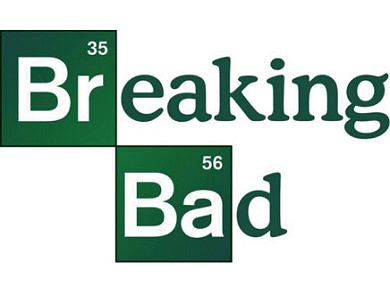
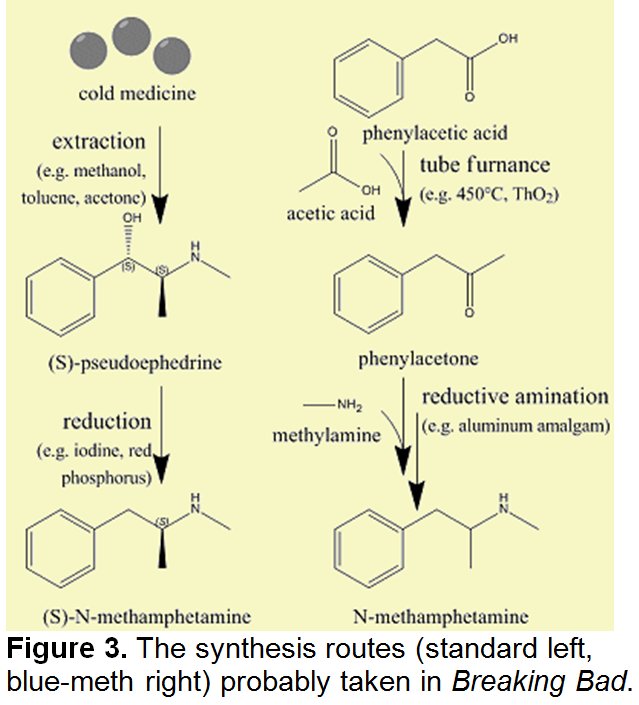




There was one error throughout the first few seasons of the show that bothered me greatly. During the opening credits when the names are shown with the chemical elements highlighted in the letters in the name one of the names (someone called Michael) has “Ch” highlighted. This was corrected in later seasons but used to bother me every episode until it was corrected.
Isn’t it “fulminate of mercury”?
How did you calculate the battery voltage?